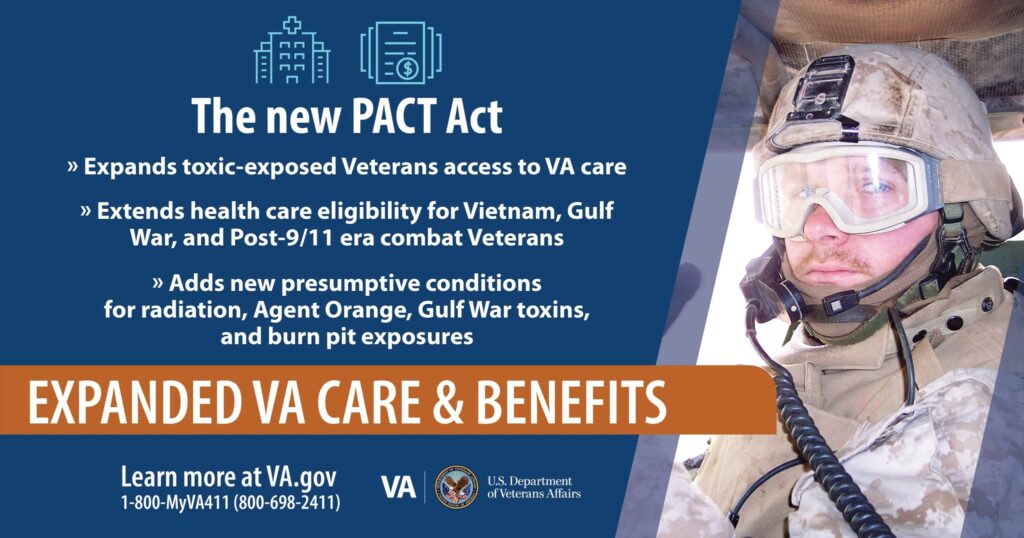What is the PACT ACT?
The full name of the law is The Sergeant First Class (SFC) Heath Robinson Honoring our Promise to Address Comprehensive Toxics (PACT) Act. The PACT Act is a new law that expands VA health care and benefits for Veterans exposed to burn pits, Agent Orange, and other toxic substances. The PACT Act adds to the list of health conditions that we assume (or “presume”) are caused by exposure to these substances.
Who should make a claim?
Everyone should get an exposure evaluation from their PCM or medical team. Even if you don’t see exposures, you think are important on the VA list, still get an evaluation, still have it documented. The list could grow as we make more progress in connecting illness with exposures. This includes Vietnam era Veterans, Gulf War era Veterans and post 9/11 Veterans.
What are the current exposures listed?
– Open burn pits and other airborne hazards
– Gulf War-related exposures
– Agent Orange
– Radiation
– Camp Lejeune contaminated water exposure
– Other exposures (think lead, asbestos, cleaning solvents, mold) *While not explicitly stated in the PACT
ACT info with the VA, the VA defines toxic exposures can be found here.)
Do you have to have been deployed to have toxic exposures?
No, not all toxic exposures are exclusive to deployed conditions, i.e. Asbestos, water on base, training-related exposures such as particulates from gunfire, artillery and aviation-related fumes etc.
What is the point of a service connection for exposures?
If you are service connected for exposures, then you will have healthcare for life for conditions related to that exposure. This means treatment for conditions related to the exposure through the VA at no cost to you. A service connection may also lead to an increase in disability percentage rating.
Is there a deadline to apply for exposure service connection?
No, but, you’ll want to get screened and apply sooner rather than later. The date to remember is Aug 10, 2023. If exposures and benefits applications are documented and submitted before Aug 10, 2023, then health coverage and presumptive backpay is retroactively backdated.
How do you make a claim?
First, you must be enrolled and connected with the VA. If you are not, visit or call your local VA to get the process started to enroll with the VA. This website outlines and has links to how to apply online, by phone (877-222-8387), in person, by mail through application (VA Form 10-10EZ), and with assistance from a trained professional. Click here for how to apply.
Next, you’ll make a claim for exposures, to do so, you should already have a diagnosis, as undiagnosed symptoms will not be deemed “service connected”, therefore it is critical to get enrolled in VA healthcare and meet with your care team. Toxic exposure screenings are available at VA health facilities across the country. Every Veteran enrolled in VA health care will receive an initial screening and a follow- up screening at least once every 5 years. Veterans who are not enrolled and who meet eligibility requirements will have an opportunity to enroll and receive the screening.
The VA give you information about any benefits, registry exams, and clinical resources you may need. If you don’t have an upcoming appointment, or if you want to get the screening sooner, contact your local VA health facility. Ask to get screened by the toxic exposure screening navigator, or contact your VA’s Environmental Healthcare Coordinator.
What conditions are deemed presumptive related to toxic exposures?
Cancers and medical illnesses related to burn pit exposure are below, note this is not an “all-inclusive list” and even if your cancer or condition is not listed, you should absolutely still apply for service-connection and disability benefits:
Brain cancer
Gastrointestinal cancer of any type
Glioblastoma Head cancer of any type
Kidney cancer
Lymphoma of any type
Melanoma
Neck cancer of any type
Pancreatic cancer
Reproductive cancer of any type
Respiratory (breathing-related) cancer of any type
Asthma that was diagnosed after service
Chronic bronchitis
Chronic obstructive pulmonary disease (COPD)
Chronic rhinitis
Chronic sinusitis
Constrictive bronchiolitis or obliterative bronchiolitis
Emphysema
Granulomatous disease
Interstitial lung disease (ILD)
Pleuritis
Pulmonary fibrosis
Sarcoidosis
For more info check out this link.
